Table of contents
If you stumbled upon this article, you might be looking to build a lean, mean, lead-generating machine.
Generating leads can be time-consuming.
Luckily, there is no shortage of great B2B lead generation tools you can use. In this post, we’re going to examine some of the top picks, including:
What is Lead Generation Software?
Lead Generation software applies to any tool that makes it easier to generate new leads.
Some of the categories of lead generation software include but are not limited to:
- CRMs – such as HubSpot CRM and Pipedrive
- Prospecting – such as Clearbit and Leadfeeder
- Data / Lead enrichment such as Hunter.io and RocketReach
- Marketing automation – such as HubSpot Marketing Cloud, ManyChat, and Clickfunnels
- Landing page builders – such as Unbounce and Leadpages
- Opt-in forms – such as OptinMonster and Sumo
- Paid Advertising channels – such as Google Ads and Linkedin Ads
How Do I Find the Best B2B Leads?
The best way to find B2B leads is to work backward from your ideal customer. When you know who your ideal customer is from their job title, key responsibilities, and where they hang out on and offline right down to their goals and pain points, it will make it easier to build a list of prospects who have similar attributes.
PRO TIP: How to track these 10 popular Google Analytics 4 metrics
Sure, there are dozens (and dozens?) more Google Analytics 4 metrics you could track. But, starting with these 10 commonly tracked metrics will give you a pretty high-level view of how your marketing is working…
- Sessions: The number of sessions can tell you how many times people are returning to your website. Obviously, the higher the better.
- Sessions by organic keyword: Which organic keywords bring in the most traffic to your website? This may help you determine whether your SEO investments are paying off.
- Bounce rate: Do visitors leave shortly after landing on your website? Or do they stick around?
- Average session duration: How much time are people spending on your website? Users with a high average session duration are most likely relevant to your company.
- Goal completions: How many users responded to your call to action?
If you want to track these in Google Analytics, you might find the visualizations limiting. It’s also a bit time-consuming to combine all the metrics you need in one view.
To better understand how your website performs in terms of traffic growth and conversions, we’ve made this plug-and-play dashboard that contains all the essential metrics for understanding how successful you are at optimizing different aspects of your website.
You can easily set it up in just a few clicks – no coding required.
To set up the dashboard, follow these 3 simple steps:
Step 1: Get the template
Step 2: Connect your Google Analytics account with Databox.
Step 3: Watch your dashboard populate in seconds.
Best B2B Lead Generation Tools
From CRMs and lead enrichment software to landing page builders and paid advertising channels, we’re looking at the top-recommended B2B lead generation tools.
- Pipedrive
- HubSpot CRM
- HubSpot Marketing Cloud
- SharpSpring
- Clearbit
- RocketReach
- Google Ads
- Adroll
- GetResponse
- FindThatLead
- Hyperise
- ClickFunnels
- LeadPages
- Unbounce
- Linkedin Sales Navigator
- Linkedin Ads
- Meetup
- Opt-in Form Builders
- Cleverly
- Octopus
- Lead Forensics
- Outfunnel
- ReachStream
- Paperform
1. Pipedrive
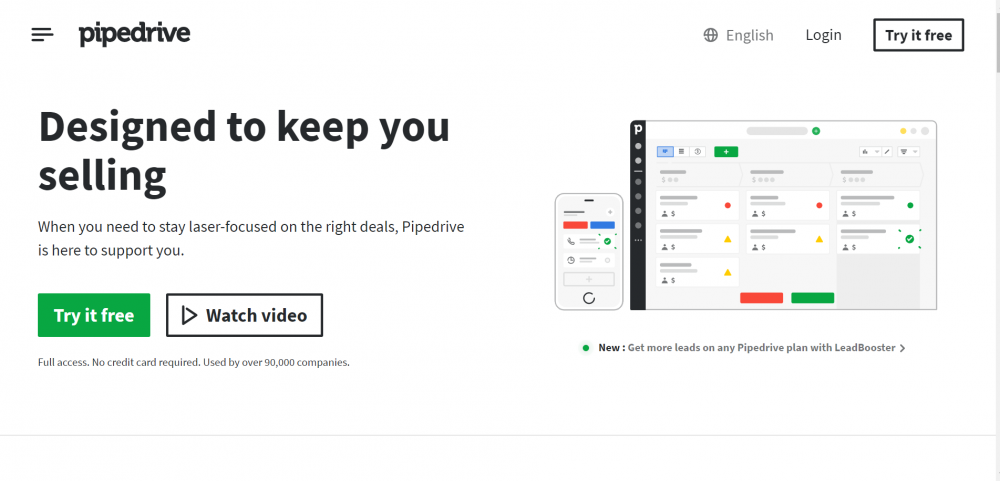
“My favorite B2B lead generation tool is Pipedrive because it encourages me to take action to develop deals,” says Bruce Harpham of SaaS Marketing Services. “It is great to use another tool to buy B2B leads. However, you ultimately need to use an outreach and tracking tool to stay on top of those deals.”
Kimberly Smith of Clarify Capital adds, “We’ve had a fantastic experience using Pipedrive for lead generation.. Using Pipedrive’s LeadBooster add-on feature, we’re able to semi-automate some of our lead generation processes. We use Chatbot and Live Chat features, which help to streamline internal processes and save our sales reps on time. It’s a nice hybrid mix of automation for aspects where there isn’t a clear value add from direct human interface, without leaving communication entirely up to an application.
As a small business, it’s important to be able to reduce waste and increase productivity without eliminating the personal, human connection unique to our company and its size. Pipedrive enables us the operational efficiency we need to thrive without taking away from the relationship building and genuineness we consider to be fundamental to our company.”
2. HubSpot CRM

“I recommend using HubSpot,” says Deepak Shukla of Pearl Lemon Sales. “Not only does it have a fantastic interface that automatically tracks leads and keeps you updated – it’s also got a free CRM available!
Joe Czarniecki of Efferent Media says, “HubSpot is truly one of the best and most robust B2B lead generation tools. Many get a bit overwhelmed when starting out using HubSpot because of the robust toolset within their dashboard.
With HubSpot, you can forget using multiple different tools for all the different aspects of your marketing efforts like email marketing, social media content scheduling, landing page creation, tracking software, CRM, automation tools, and a huge set of integrations that can be used for things like call tracking and call recording.”
Alex Birkett of Omniscient Digital adds, “On the freemium tier, you’ve already got access to all the tools you need to run a lead generation campaign from start to finish – an Ads manager, landing page builder, lead capture forms, email marketing, and basic automation. It gets quite powerful on paid tiers, though, when you can tap into advanced automation, A/B testing, etc. I love that everything is on one platform and all syncs up to the CRM.”
3. HubSpot Marketing Cloud
“Hubspot because it gives us so much valuable insight into which one of our blog posts and landing pages generate the most incoming traffic as well as repeat visitors,” says Jake Rheude of Red Stag Fulfillment. “That data has helped dictate our content strategy over and helped us formulate new ideas for articles based on what seems to draw the most visitors. Hubspot has made it much easier for us to track and manage this aspect of our content.”
Oliver Andrews of OA Design Services says, “When you’re ready to scale and want a more unified view of your lead generation activity, Hubspot is the way to go. As they expanded their product line from a marketing tool to marketing, sales, and support platform, it offers lead generation tools to the end of the customer journey. But even starting with some of the free marketing and sales tools will help increase your b2b lead generation efforts in 2020.”
Mike Tatum of Kinsta adds, “I see a CRM and a marketing automation system as the core of every lead generation program, and I love HubSpot because it’s strong in both of those areas. HubSpot has a rare mix of power and ease-of-use that most CRM and marketing automation tools just don’t.
What really gives it the edge over many other tools out there is that it makes the collaboration between marketing and sales seamless. I’ve seen every successful B2B business the common trait is always that the marketing and sales are always on the same page and are actioning on the same information in real-time, and that’s what HubSpot allows you to do.”
For example, Mariana Godsen of Remotish says, “In HubSpot, we can set a variety of rules to show the bot on certain website pages and exclude a specific group of people depending on what the bot is for. For example, you can set rules not to show the bot for visitors of a specific country or a certain lifecycle stage. I love bots because they allow us to collect data 24/7 and route our leads to the right place, such as a piece of content, the meeting link of a team member, and ask the questions we need to qualify a lead and solve their problem faster. My favorite thing about this tool in HubSpot is the flexibility to set up the bot for a variety of situations and needs from the visitor efficiently.”
4. SharpSpring
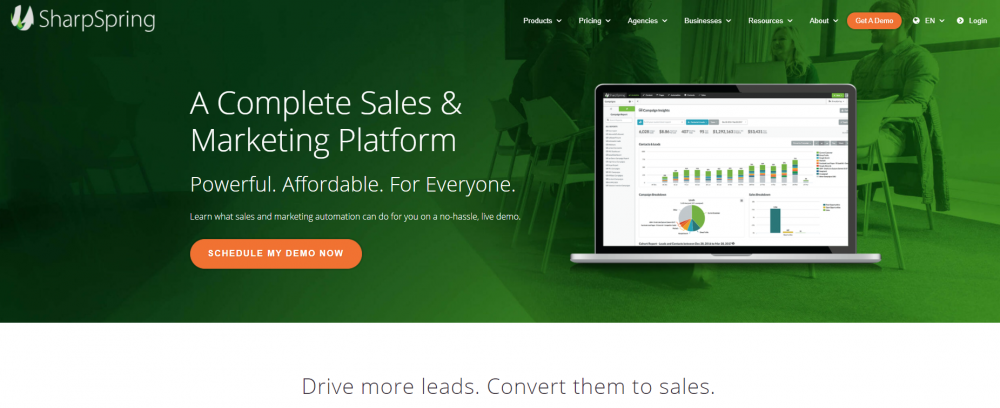
An alternative to HubSpot is Sharpspring.
“This is a marketing automation solution with a built-in CRM,” says Mark Lennon of Espresso B2B Marketing. “It provides the central database for all sales and marketing activities. It also tracks everything: anonymous website visitors, leads, contacts, opportunities, and sales. It also provides a sales funnel, lead scoring, marketing analytics, email marketing, web forms, social media post scheduling, workflow and automation, and tons more.”
5. Clearbit
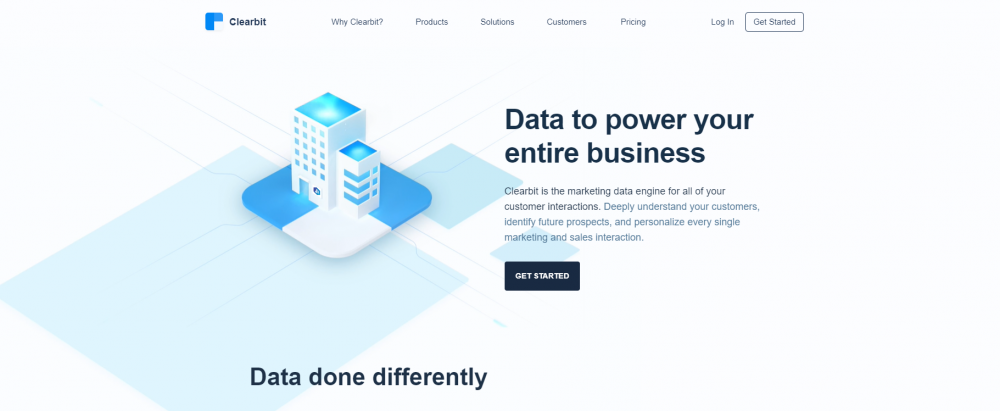
“My favorite B2B lead generation tool is Clearbit,” says Alex Kaschuta of Fundsquire. “The integrations are smooth, the database is huge, and the data enrichment they provide really helps us make the best decision around targeting. If you don’t want to pay for the whole nine yards, the chrome extension can work well for small sales teams as well.”
Adam Corey of Podable adds, “The trifecta for lead generation is Clearbit, Intercom, and Outreach.io. You can identify and engage anonymous website traffic with onsite chat, customized calls-to-action, and even trigger follow-up outreach campaigns.”
6. RocketReach
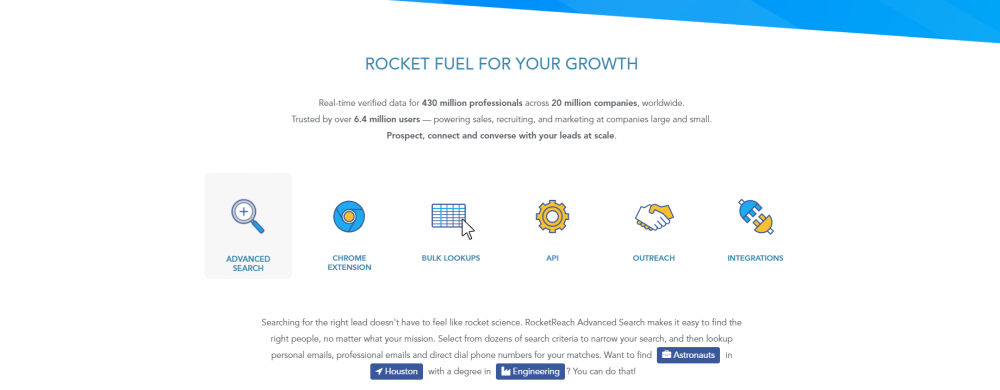
“Tools such as RocketReach and Hunter.io make it easy to find the personal contact details of key decision-makers and are worth every penny,” says Dror Wayne.
7. Google Ads

“Google Ads for lead generation is still an excellent way to receive high-quality leads,” says Alexandra Zamolo of Beekeeper. “With all of Google’s technology and their ability to show ads to consumers who may be interested in those products or services, it’s an excellent way to ensure that you’re not sifting through a bunch of leads that won’t transfer to conversions.
Myles Daniel of Sell My House Fast Greenville says, “Google Ads is my favorite B2B lead generation source. Almost everyone depends on Google for answers. When my clients are looking for someone like me, they usually type in keywords on Google, and my ad is right in front of them. It’s a reliable, consistent, and most importantly, a predictable marketing tool.”
Charlie Worrall of Imaginaire adds, “By learning about the best practices, we’re able to implement these strategies ourselves, which means that we have better control over what we’re doing and how much we’re spending. It’s also a straightforward platform for us to use, which means that we can navigate and make changes simply. However, having a consultant that knows the ins and outs will always be helpful.”
Cyrus Yung of Assun Motor agrees, “Once we are ranked organically for our targeted product keywords, we want to show 2 results to our target audience to dominate the search results.
We only targeted phrases and exact match type on Google Ads, and we kept adding in the negative keywords that are not relevant.”
For example, Robert Katai of Bannersnack says, “If you want to generate leads easily, you just need to create a lead form extension and assign it to your ads used in your Search, YouTube or Discovery campaigns.
It will also be available in Display campaigns later this year. This extension can generate high-quality leads because you can show a lead form directly in your ads, which you uploaded in your well-targeted campaigns.
This way you offer your audience an easy way to share information while they search, discover, or watch relevant content. You can ask your audience for information regarding name, email, phone, postal code, city, state, country, company name, job title, work email, or work phone.
Besides this, there is an option to add questions to your form. You can choose from pre-set industry-based questions. For example, in the case of B2B, you can choose from the following questions:
- What size is your company?
- What is your annual sales volume?
- How many years have you been in business?
- What is your job department?
- What is your job role?
Because your goal isn’t just simply generating leads and you want those leads converted into sales, you need to connect your converted leads to your campaigns. Google Ads offers you the opportunity to use a webhook to manage the collected leads. For this, you can use Zapier, which offers you the possibility to connect Google’s lead form extensions and webhooks to your email marketing, marketing automation, and CRM apps. This is a great help when it comes to automating the lead nurturing process.” Use this lead generation dashboard to monitor the number of leads that come from Google Ads.
8. Adroll

“Adroll is my favorite because, with Adroll, it’s effortless for my team to find the target audience and also create cross-channel experiences that allow us to retain customers,” says Jigar Agrawal of eSparkBiz Technologies. “It also allows us to measure our performance and long-term impacts.”
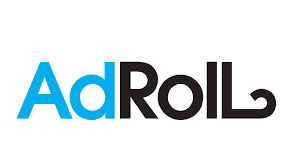
9. GetResponse

“As a digital marketer, I have tried ActiveCampaign in the past, and currently, I use GetResponse, which is my favorite B2B lead generation tool,” says Chuks Chukwuemeka of DepreneurDigest. “I prefer it because it’s easy to navigate and offers all the advanced features I need to generate quality leads.”
10. FindThatLead

“My favorite lead generation tool is FindThatLead,” says Dima Suponau. “I’ve been using it for quite some time now with great results. I love the simple interface and intuitive, user-friendly usage. I love conducting my email campaigns through FindThatLead because it’s so easy and highly effective. It lets me find email addresses, both for the whole domain and for the name, in a blink. It has an email verification feature that helps immensely. The Prospector tool helps with finding very specific leads.”
11. Hyperise

“We recently discovered Hyperise, which is a ridiculously cool tool,” says Katheriin Liibert of Outfunnel. “You can use it to hyper-personalize your website, add personalized images into your email outreach at scale, and more, without any coding. It’s really something that will make your lead gen stand out.”
12. ClickFunnels
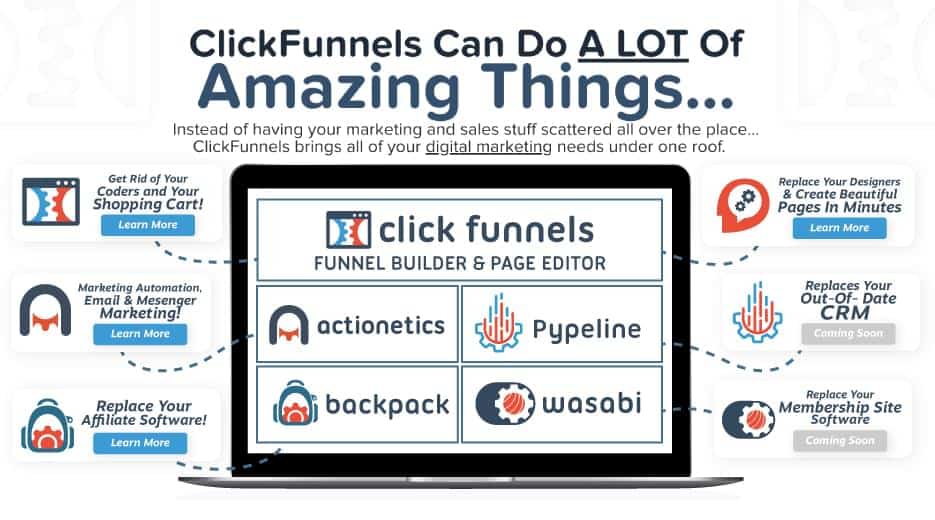
“We use ClickFunnels to create optimal sales funnels and an easy-to-use membership portal so we can attract and retain new and existing community members and clients effectively,” says Grant Bartel of Top Digital Real Estate. “One of the most valuable qualities ClickFunnels has to offer us is the ability to automate our entire back-end sales and marketing processes as well as being able to track analytics easily. That frees up a ton of our time and gives us the insights we need to improve our business.”
13. LeadPages
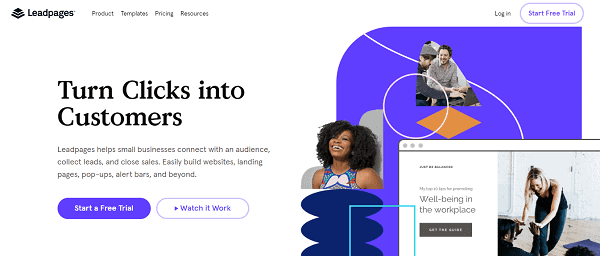
“If you want to increase the efficiency in creating a lead generation experience for all your campaigns, LeadPages is a reliable tool you can use,” says Dennis Bell of Byblos Coffee.
“LeadPages is my favorite B2B lead generation tool. It has a drag-and-drop feature that makes it easy for me to create attractive and user-friendly landing pages for my website, which helps me convert traffic into leads. I’m using LeadPages as it integrates well with Facebook Ads to funnel users directly to my landing pages.
I have everything I need to create a custom landing page that fits my brand’s needs. There’s a lot of template options to choose from to increase engagement with my landing pages. Through the use of Leadboxes and pop-up CTAs, it directs traffic to my website, which helps to close more sales for my business.
Generating B2B leads is not easy. It takes a lot of time, effort, and resources. LeadPages will make the process of converting visitors as simple as possible. By designing your landing pages well, converting visitors will be much easier.LeadPages”
14. Unbounce
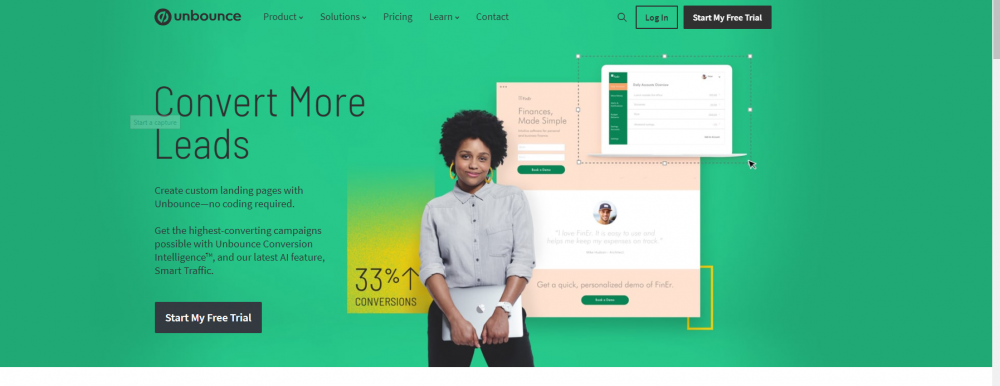
“One of my favorite stand-alone lead generation software tools would have to be Unbounce,” says James Canzanella of IMNights. “Aside from being priced just right, they place a high emphasis on converting more with the landing pages you create.
Overall, this tool is a breeze when it comes to getting started, putting landing pages together, and applying additional features to help increase your conversions even more, such as using popups and sticky bars.”
Johan Hajji of Upperkey adds, “As far as building landing pages goes, I think it’s the best tool on the market now. I love its simplicity and that I can build a landing page or popup that’s efficient very quickly. Their drag and drop builder and editor is superbly intuitive and user-friendly.
I also value the A/B testing feature because data-driven marketing is the way to go. Using that, I can see exactly what works and what needs fixing. The analytics and insights it provides are in-depth and invaluable to me. I also love their unique smart traffic feature, which tells me the details on each lead, such as their location and the device they’re using.”
15. Linkedin
“My favorite lead generation tool is LinkedIn,” says Irene Lopez of Online Optimism. “While advertising on LinkedIn has its merits, utilizing LinkedIn as a way to connect with like-minded individuals is what separates the platform from the rest. Users utilize LinkedIn to build awareness of themselves and their brand to connect better with people within their industry.”
16. Linkedin Sales Navigator

If you are a Linkedin power user, it may be useful to invest in Linkedin Sales Navigator.
Brian Cairns of ProStrategix Consulting says, “LinkedIn Sales navigator has worked best for us. Its ability to target is the winning asset for us.
There are so many options that it is a great fit as a B2B solution. The ability to directly message potential leads is a great feature, too. This type of categorized scoping can be also automated by utilizing LinkedHelper which is a lead generation tool for LinkedIn.
The downside to LinkedIn is it is all manual – assuming you follow their policies. Many don’t, but we’ve found that personalization is key to winning on LinkedIn. While it is very time-consuming, it has proven to be worth the effort.”
Matthew Stormoen of Mobibi, Inc. agrees, “My favorite B2B lead generation tool is LinkedIn, specifically the LinkedIn Sales Navigator.
It’s very convenient to use especially if you’re on the platform already.
For a startup founder like me who might be juggling multiple roles (I initially also handled lead generation for my startup, Mobibi), LinkedIn Sales Navigator has been beneficial in finding, saving, and getting in touch with leads, whether potential investors or early adopters of our content marketing platform. We are still currently using LinkedIn Sales Navigator to find, save, and get in touch with leads. It has been a lifesaver, especially in the context of the global pandemic.”
Jonathan Aufray of Growth Hackers Marketing adds, “When outreaching to leads on LinkedIn, build a relationship first. Don’t be too salesy right away. It’s important to build a relationship by introducing yourself. Get interested in your leads, asking questions, sharing insightful and helpful content with them.
Once you’ve built rapport, you will know what they struggle with and if you have the right solution for them. Don’t be salesy if you are not an actual fit or match for what they’re looking for. They might guide you to the right people to connect with instead.”
17. Linkedin Ads
“My favorite B2B lead generation tool is hands-down LinkedIn Ads,” says Nada Pupovac of No Bounds Digital. “Many would argue that it’s expensive, but the quality of the leads coming through and converting to paying customers is just worth it. At least that’s what my experience tells me.
If you do your homework to get to know who your buyer persona is and then put an effort to set the targeting right (together with the appealing ad copy, image, and landing page), you should expect success.
The conversion rate from leads to customers can be pretty high. We were able to achieve a 50% lead-to-customer conversion rate for a client who struggled to attract and convert quality leads with other channels just a few months before they started working with us.
Andrea Loubier of Mailbird says, “Paid advertisements are still one of the best ways to generate leads and, at the exact same time, qualify them. With targeted ad placements, we are able to reach a specific demographic, geographic location, or numerous other potential customers.”
Tiffany Lewis of More Meaningful Marketing adds, “You have the opportunity to get really niche in the type of business you’re trying to market to and provide a solution for a specific problem a company could be having.
18. Meetup
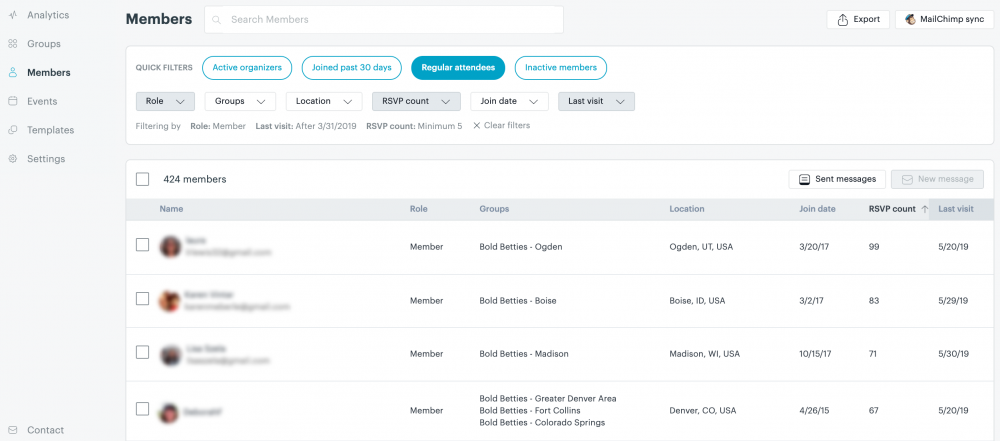
“A bit out of the box, but depending on your industry, Meetup can be a great way to generate B2B leads,” says Yasmeen Kaur of Chemcare.
“You can always find events or meetups in your area related to your niche. You can opt to contact an organizer and become a speaker to put yourself in front of an audience that listens. Another option is to start an event yourself and make it an avenue to share the opportunity you’re offering and increase awareness.
Be sure, though, to not just sell your products or services but also to provide value — look for other speakers the audience can engage with.”
19. Opt-in Forms
Janice Wald of Mostly Blogging says, “My favorite lead generation tool is my opt-in form. You need a form to generate leads.
Once people fill out your form, they are on your list, and you can contact them. You own the list, so you have peace of mind knowing that you have the emails whatever happens.
On the optin form, you let people know what they get for signing up, which gets you even more leads. Email vendors enable you to put the form on your posts, in your sidebar, and even on social media sites like Facebook.”
For example, many different form builders are available, including OptinMonster, JotForm, Sumo, and RightMessage. In addition, most email marketing platforms – such as Mailchimp, ConvertKit, and Klaviyo – also have their own built-in sign-up forms that you can embed on your website.
20. Cleverly
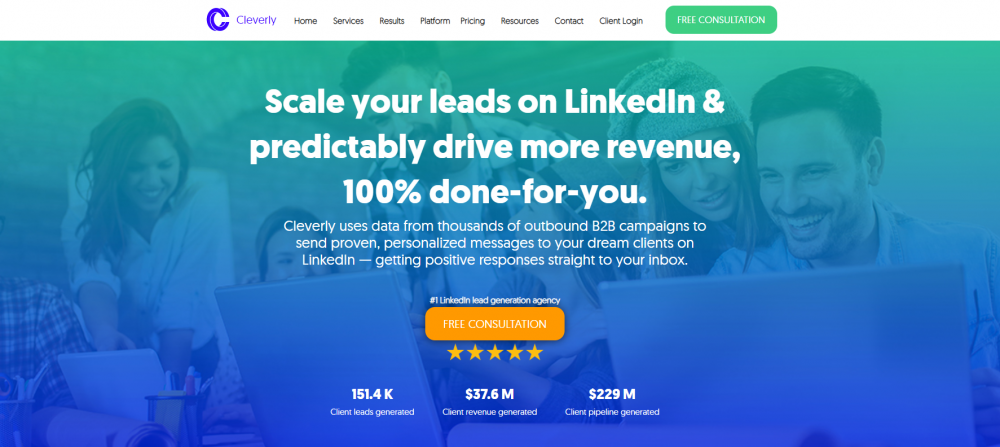
“It’s really going to depend on your target industry/vertical, but one that’s really effective is Cleverly,” says Chris Wilks of BrandExtract. “It’s a tool that automates your LinkedIn outreach, so it essentially takes the place of hiring a junior salesperson. The one caveat is that it does require a subscription to LinkedIn Sales Navigator.”
21. Octopus
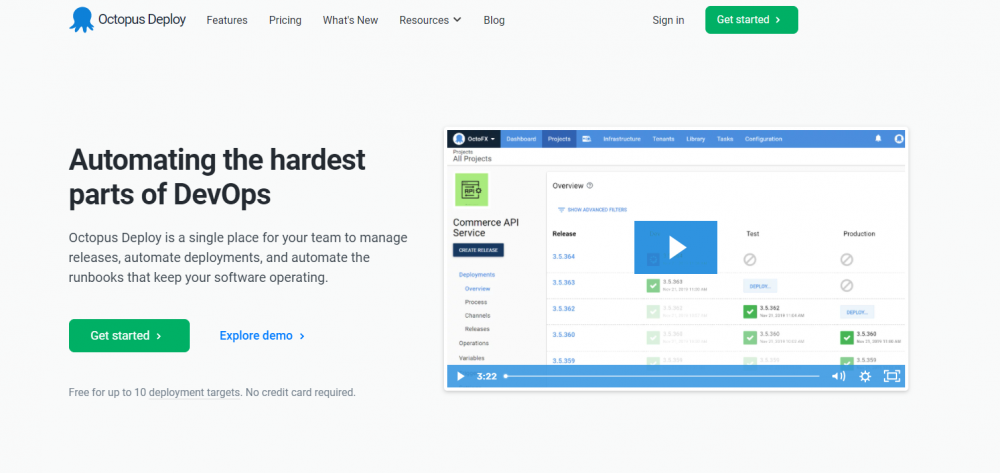
“Our favorite lead generation tool is Octopus, which serves as an automation tool for LinkedIn,” says Craig Smith of Trinity.one. “It automates the tedious tasks of connecting and communication and allows this at scale with a marketer given the ability to nurture contacts within the LinkedIn ecosystem. We currently use the following lead generation tools.”
22. Lead Forensics

“Personally I prefer Lead Forensics over other B2B lead generation tools because sometimes they can miss out on where the traffic is pulling from, and when a person doesn’t know the origin of consumers they aren’t able to specify the ad targeted towards them,” says Catriona Jasica of Top Vouchers Code. “With Lead Forensics, trouble like this doesn’t occur because it has everything a person needs to analyze the data to create a perfect ad.”
23. Outfunnel
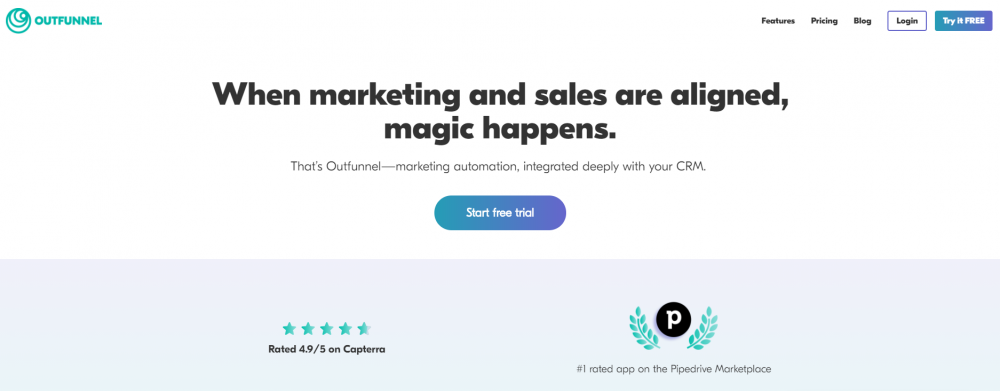
“Recently, I discovered Outfunnel that offers lightweight lead nurturing email automation that’s tightly integrated with your CRM,” says Johannes Kanter of GettingGrowth. “Its functionality is basic but solid—but its data syncing integration is really the best-in-class.”
24. ReachStream
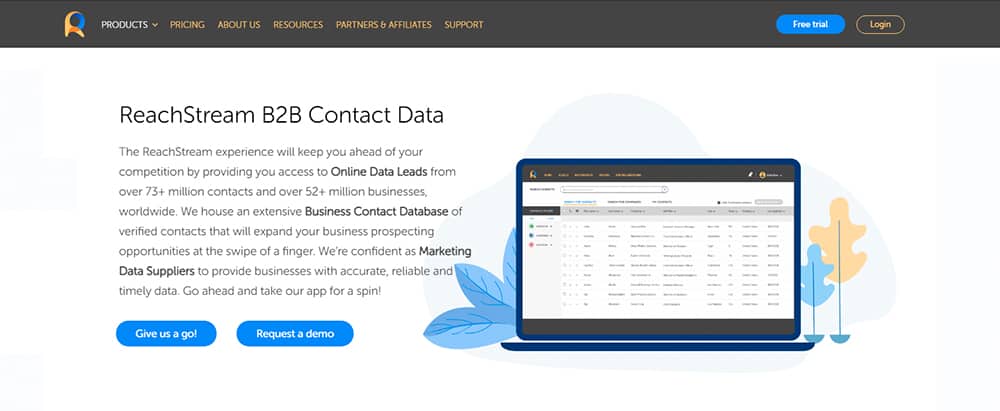
Lauren Reilly of SuitUp explains how ReachStream helped the company to generate more B2B leads, “We were looking to get a list of reliable contacts to carry forward our business goals. After approaching ReachStream, we were able to acquire a specific, verified, and updated list of contacts which helped us increase our reach as an organization.”
“We were really impressed with the outcomes of our email marketing campaign after starting to use Reach Stream,” says Kenneth Walton of Data Collaboration Service.
25. Paperform

“Prior to using Paperform, we had to invest in tons of different tools to cover multiple business functions like lead generation and user feedback. This not only resulted in hours worth of manual work, it also meant that information was scattered all over the place. We had to work double the amount to adapt styles on each one of these platforms, trying to make them all work together.” Says Garbiñe Hoyo Martínez from ReasonWhy.
“Lead capture is another function that has been completely automated with Paperform; we have a bunch of short forms to collect leads on our website, which automatically send lead data to our emailing app, saving us hours of manual work whilst ensuring that anyone who signs up receives our intended email sequence in their inbox”
“Paperform has been an effortless way for us to grow our email list with an engaged audience,” Michelle of Northern Manhattan Arts Alliance goes on to explain: “In fact, 25% of our mailing list is from Paperform, while 36% of our new contacts last month were from Paperform as well.”
While these B2B lead generation tools can help you generate more leads, they aren’t a replacement for having a lead generation strategy. It is always best to create your strategy first and then leverage tools to help you accomplish your goals.















